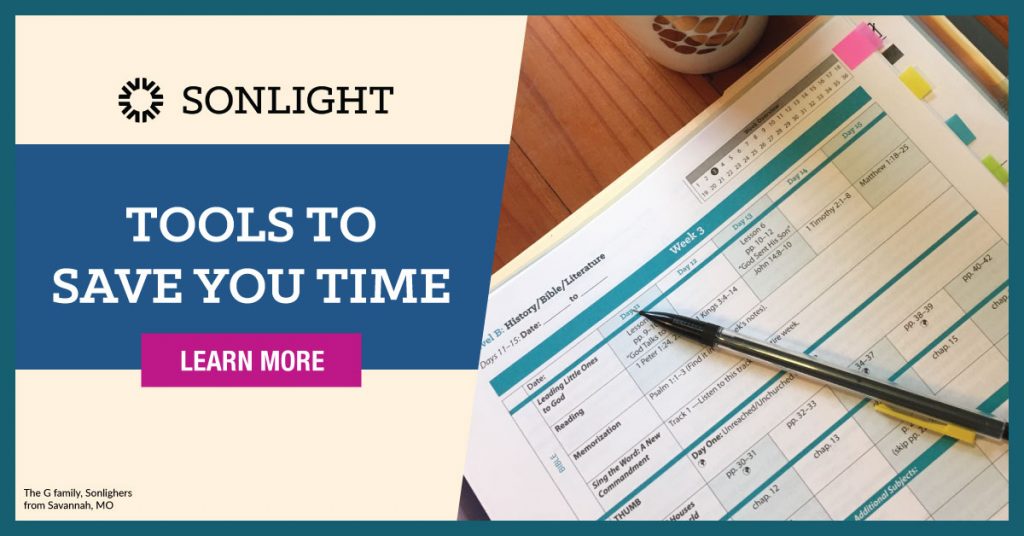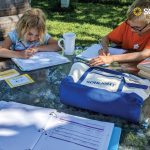Do you frequently run into days when you have more subjects on your to-do list than time in the day to teach it? Do you wish it were easier to carry things over to the next day instead of trying to cram it all in one? Would you like to spread your curriculum out over a longer time period or run a lighter schedule of many subjects during the summer? If so, loop scheduling may work for you.

Loop scheduling may look complicated, but once you understand the concept behind it, it’s easy to use. To demonstrate the concept, let's take the easy-to-understand example of color-coded outfits.
The Color-coded Sequence of Outfits
Let’s pretend you are tired of deciding what your children will wear each day, so you buy 10 outfits for each child in each of the following colors and hang them in the closet in this order:
- red
- blue
- green
- orange
- white
- purple
- yellow
- black
- pink
- teal
The first day, you get your children up and dress them in red. The next day, they put on the blue outfits.
Maybe that day they need to go with you to the grocery store, but they’ve gotten their blue outfits a little dirty. No problem! You go to the next outfit in the sequence—the green ones. Later that night, they ask to change, so you dress them in the orange outfit next.
The next morning you're down to the white outfits. And so on.
Eventually, they’ll come around to the teal outfits and be out of clothes. Presumably, by then you will have done laundry, and the red outfits will be ready to wear again. So you start back up the top of the ten colors again with red.
Making the Parallel to Your Homeschool Schedule
Now let's apply that same principle to your homeschool schedule. Make a list of each subject you would like in your loop and list them in order.
- Bible
- History
- Literature or Read-Alouds
- Language Arts
- Handwriting
- Creative Writing
- Science
- Math
- Art
- Music
When you begin your homeschool day, you start at the top and move down the list, doing each subject in order. Whenever you stop for the day, you mark off the last subject you completed. When you resume lessons again the next day, you simply pick up where you left off. Eventually you will reach the end of the list and start again at the top.
Wearing Jeans Everyday (Adding Block Scheduling to Your Loop)
What if you don’t want your children to be dressed from head to toe in red? Maybe they want to wear jeans each day just like I want to cover Bible every day.
Well, that’s simple. The jeans are a constant every day, but your kids still cycle through the different colored tops.
For the homeschool equivalent, you put Bible into a block schedule by itself and then cover the rest of the topics on a loop once Bible is done each day.
DAILY
- Bible
LOOP
- History
- Literature or Read-Alouds
- Language Arts
- Handwriting
- Creative Writing
- Science
- Math
- Art
- Music
Fancy Schedules with Multiple Homeschool Loops
Let’s say your children don't want to wear jeans every day. They want to vary their bottoms on a loop schedule as well as their tops. You can make a second loop of bottoms:
- jeans
- slacks/skirts
- shorts
In this case, you use both loops at the same time. So your child would follow this sequence:
- jeans with a red top
- slacks/skirt with a blue top
- shorts with a green shirt
Once you complete a loop, you repeat it. So the pattern continues for the bottoms while you keep working through the original list of colored tops:
- jeans with an orange shirt
- slacks/skirt with a white top
- shorts with a purple shirt
Now let's apply double loops to homeschooling. Maybe you want a loop that alternates history and science every other day. Bible is still your daily subject. Here's how that looks in list form:
DAILY
- Bible
LOOP #1
- History
- Science
LOOP #2
- Literature or Read-Alouds
- Language Arts
- Handwriting
- Creative Writing
- Math
- Art
- Music
Each day you cover Bible. Then you study either history or science. And finally you work through the original loop.
Customizing the Loops
These loops can work however you want because they are easy to customize. Some people like to study Bible, Math, Foreign Language, and Reading daily while looping History and Science into an alternating schedule. Other topics are covered three times a week on a separate loop.
As you can see, loop schedules can be as simple or as complex as you want them to be. The loop gives you the order to cover topics so you know you are making constant progress in each subject.
Keeping Track of the Loops
Keeping up with where you are in your loops is simple. I have a written list of my loops, and I use those repositionable arrow tabs—the ones used to indicate where to sign a document—to keep my place.
The same idea works in my Sonlight Instructor’s Guide. I simply place a tab on the square I need to cover next in the loop.
Getting Off Schedule
Sometimes our loop schedules get thrown for a loop! But it's not a huge problem.
Back to our clothing analogy, let’s say your children were supposed to wear orange today, but instead were invited to a ceremony where they had to dress up and their clothes didn’t match what was on the loop schedule.
The homeschool parallel may be that your dish washer broke down halfway through Handwriting, so you gave your children an Art project to keep them busy while you try to figure out the appliance issue.
Here's the solution. When the odd situation is over, you pick up where you were as if nothing took you off your schedule. There's no need to stress if it takes a day or two (or twelve) to get back to your schedule. It’ll wait for you.
Benefits of the Loop Schedule
Loop schedules are great because they relieve the pressure to finish everything in one day while still keeping you from falling behind in any one subject. You can have one child on one set of loops and another child on a different set of loops.
These schedules help you keep track of what you’ve done and what needs to be done. They are perfect for stretching a History / Bible / Literature program beyond a typical 36-week schedule.
If you need to change your schedule or switch up how it works, simply make a new list, and you’re ready to go again. There’s really no wrong way to do them.

If you love an organized homeschool, you'll love Sonlight. Your Instructor's Guides are like a personal homeschool mentor who plans and organizes your entire homeschool year.








This is an excellent form of organization.
thank you for explaining this so clearly. It makes so much sense!
I basically do looping without even knowing it. We rotate science and history every other day and we rotate art and health every other day. We do writing, bible, and reading every day.